Check out our range of stock.
Didn't find what you like?
Send us a message
Found something out of stock?
Send us a message
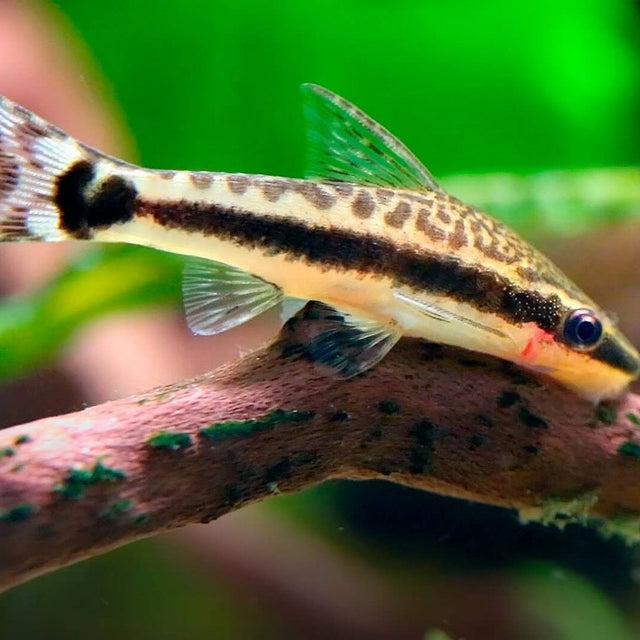
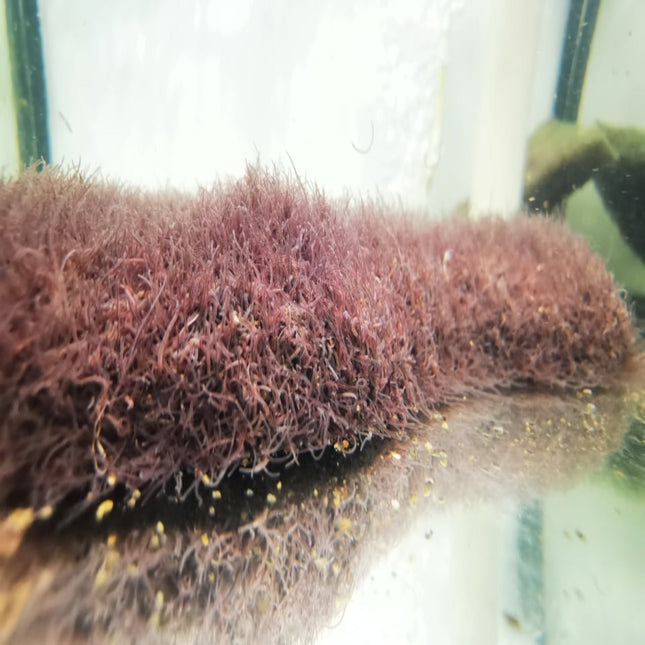
OUR NEXT SHIPMENT IS FIRST WEEK OF THE MONTH THIS PRODUCT IS BEST FOR THOSE WHO COME TO THE SHOP AND PICKUP FROM THE SHOP. IT DOESN'T SHIP WELL IF YOU ARE INTERSTATE OR IN A RURAL AREA. Live Blackworms are harvested fresh in Victoria We always have these worms in stock (however it will depend on the demand) When we send these they need to be kept cold with ice. Please note that we only will send this via Toll Priority (Overnight) Service which is $35 SHIPPING IS NOT AVAILABLE FOR THIS BETWEEN NOVEMBER TO FEBRUARY. THERE IS NO DOA GUARANTEE FOR THIS PRODUCT. We do not ship this product to rural areas as they will NOT survive. Live Black worms are harvested fresh in Victoria These worms have a high protein 46% to fat 20% ratio and are the ideal food for breeding fish or the increased mass of young. However please make sure that you feed your fish sparingly Live Black worms as fish can get constipated and this will cause dropsy or bloat on the fish. We strive in maintaining a healthy stock at all times and we will make every effort to provide the necessary advice to make sure they are kept alive in optimum condition. If you are looking to keep this long term then please let us know so we can advise you accordingly LIVE BLACK WORMS What are Black Worms? Live Black Worms is a species called Lumbriculus variegatus and come from very cool climates in shallow-water marshes, ponds, and swamps, feeding on microorganisms and organic material. Where are Black Worms from? Live Black Worms originated from North America and Europe. However, we get our worms fresh from Victoria. How often do you have Live Black Worms? We get our worms usually on a Tuesday or Wednesday of the week. We usually get around 1-2kg of Live Black Worms. This is why when you purchase our worms they are always fresh What do you mean by 30mL or 1L? Does that include water? When we write 30mL or 1L that is the volume of worms you get. We send our worms with as little water in the bag as possible. The reason why we don’t send it with water is that the water gets dirty very quickly with Ammonia. Where do black worms live? These are harvested from clean water that gets its water from the Victorian Alps Vineyards and other crop-thirsty plants also are grown in the area. How do you keep black worms alive? Black worms need fast-moving water to keep them alive. We recommend that you use a sponge filter for smaller amounts. Larger amounts would require you to use a sump filter. Can you breed black worms? Black worms can breed readily in an aquarium setting. They breed in two ways. The first is asexual where they rub off hard surfaces and ‘break off.’ When they do, the head will grow a tail and the tail a head. The other way they breed is via eggs. However, we have discovered that egg produced by black worms is quite minimal. It should be considered that if you wish to produce live black worms economically you do need readily available water and high-protein food. But ultimately growing black worms is uneconomical for a home hobbyist and we encourage you to consider (to save time) getting it from Nano Tanks. Are black worms harmful to humans? Black worms are not harmful to humans if you touch them. However, if you suffer from dermatitis or other skin conditions it is known that black worms will cause a reaction to your skin. To avoid such contact we advise that you use gloves for this very purpose. Naturally, there are bacteria and other worms, leaf leaches and etc that come with the worms. These are grown naturally with the worms and should not harm humans. As a rule, however, it is advisable that you wash your hands thoroughly with a properly antibacterial agent. How do you send your black worms? When we send these worms, they need to be kept cold with ice. Please be aware of your ambient temperature and that the heat will kill them. We only will send this via Toll Priority/ Australia Post Express Post Service please make sure you select the Live Fish Shipping option
$10.00 - $175.00
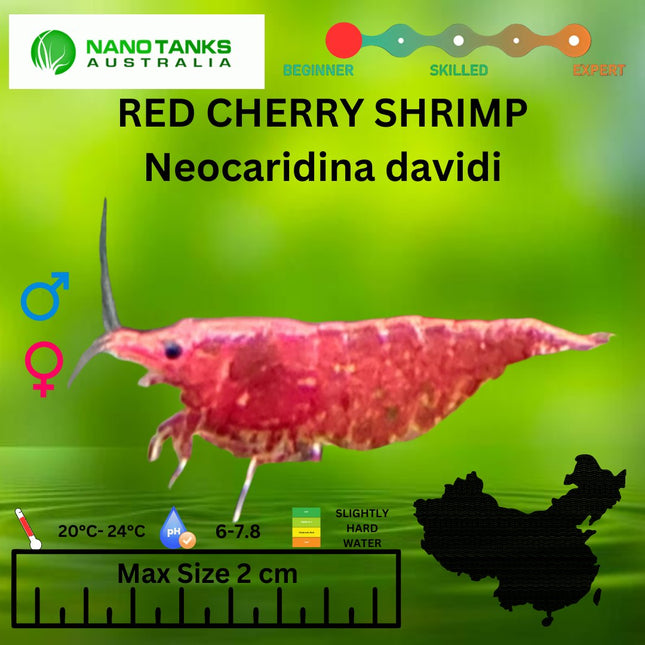
Cherry Shrimp Types & Price Cherry Shrimps RCS Neocaridina davidi is one of the most beautiful and sought after shrimp in the hobby today. They are easy to care for and easy to breed in a freshwater aquarium. These freshwater shrimps also are priced for the beginners market. Red Cherry Shrimp When you get our shrimps they are mostly a B or C class shrimp. This means that they will appear red, however their quality is not as consistent as the highest grade. We do have Bloody Mary and Fire Red Shrimps that come from time to time however these strains are hard to get and there are cost implication that come with them. If you are interested in these premium kinds of shrimps please message us. Blue Cherry Shrimp & Yellow Cherry Shrimp These colour variations are not as popular as red cherry's however they look amazing in their own way. Our particular variant of Blue Cherry Shrimp is called Blue Dreams. Our Yellow Cherry Shrimps can look quite stunning against particular backgrounds. Living Conditions Dwarf Shrimps are adaptable to a wide variety of tank conditions and water parameters. They can withstand temperatures to around 15°C through to 30°C. However they do prefer to be around 22°C to 26°C. The shrimps are also tolerable in a wide array of pH. However they do better when the pH is around 6.5. RCS (Red Cherry Shrimp) is very tolerable to TDS levels however, we recommend you keep your TDS (Total Dissolved Solids) to around 200ppm max. The History of Shrimp in Australia Red Cherry's appeared in Australia in the early 2000s. The price at this time was quite high and the shrimps unfortunately were not very nicely coloured. The price of the shrimps, fortunately, tumbled quickly as people discovered that they were very easy to care for and breed readily. In 2014 they reached around 50 cents (!!) AUD and people started giving up on these shrimps just because they were easy to breed. When we opened in early 2014 we were fortunate to be the first shop to sell these shrimps in bulk and we were proud to be selling them as low as $1 per shrimp (at that time). However, as we fast forward to the present and beyond, the price of these shrimps has increased steadily due to the necessary upkeep requirements for ensuring healthy shrimps for sale. Now, these shrimps are more than a staple in the Aquarium hobby and a great addition to add for those starting out in shrimp keeping and Aquascaping in general. What fish live with red cherry shrimp? There are a lot of fish that live with red cherry shrimp. You should consider keeping it with anything that won’t target the shrimp. The Red Cherry Shrimps make an irresistible target to predation. To keep it safe and as a rule of thumb, don’t keep shrimps with Barbs, Bettas or anything that can predate it. Even if the fish do not eat the shrimp, having planted aquariums allow for a safe place so your cherries are happy. How long do red cherry shrimp live for? Cherry Shrimps live for around 1-2 years. However, remember that when they are born they are born live and you can observe little shrimps in the tank. Most stores will sell shrimps at around 3-6 months. At this stage it is the best and ideal time for them to go to their new homes. Do Cherry shrimps breed easily? Cherry Shrimps breed very easily and to make sure they do breed, I recommend that you put them in with Bristlenose algae eater. The combination of having a Bristlenose and Cherry Shrimps means that they will consistently breed. Only use a sponge filter and do not keep with other fish if you wish for success. If the tank is new and does not contain sufficient algae, algae wafers are fine to use as this is what baby shrimps eat. Females who are carrying the eggs will have a cluster of between 30 and 50 eggs at a time beneath their tails. Properly bred, 10 shrimps can turn into 1000 in 6 months! Do cherry shrimp need a filter? Cherry shrimps do need a filter to live. However, don’t go overboard on the filtration. A simple sponge filter or internal filter will be more than sufficient for it. Do cherry shrimp eat fish poop? Cherry Shrimps don’t generally eat fish poop, however they will eat Bristlenose poo readily. I believe it is due to the wood that Bristlenose Eat that the Red Cherry Shrimps like as well. I do recommend that you also do feed your Cherry Shrimps to make sure that they are always in great form. Do cherry shrimp jump out of tank? Cherry Shrimps do not necessarily jump out of a tank. However if you give them a way.. like a filter wool climbing area or anything rough they will wonder around. When this happens please make sure that you keep your lids secure. How do you know if cherry shrimp are happy? You know that your cherry shrimps are happy because they will swim around readily and scavenge food in your tank. However, once they become still or unresponsive you will have problems. One of the worst you can ever do with shrimps is when you spray an aerosol in the house. Such as a fly spray or anything that will kill bugs. If and when you do this death will be swift! Why do shrimp drop eggs? Sometimes when RCS molt they might drop their eggs. This means that the eggs were not viable or there is a problem with the water conditions. When this happen we recommend you ignore it at first. However, if this occurs frequently we recommend that you get your water tested to make sure that everything is ok. Are red cherry shrimp Hardy? Red Cherry Shrimps are hardy. They can be totally ignored and you don’t need to really worry about them. The old adage with shrimps is that the more you care for them the worst they can get. What plants do cherry shrimp like? Shrimps loves mosses or anything that they can hide and cover themselves in. If you are looking for things like Susswassertang or Java Moss these are the simplest and the best options. Can cherry shrimp live with bettas? Before we answer the question can Cherry Shrimps live with Bettas, we need to clarify the question further and make it more specific. One betta cannot live with one Cherry Shrimp. One will be food and one will be full. However, if you have 1 betta with say 12 shrimps and heaps of cover in the tank they they can live together with no issues. The reason for this is because it is hard for the betta to focus on the one shrimp. Can you eat red cherry shrimp? You can but why would you? A cherry shrimp is such a small size and you will need a lot of it to really make a meal out of them. If you intend to breed for your human consumption, I would strongly advise against it. My shrimps came today and they look transparent! What should I do? When we transport shrimps they may turn transparent as they are stressed. When you put them in the tank their colours will return. We do not send shrimps to WA, TAS or NT
$5.00 $4.00
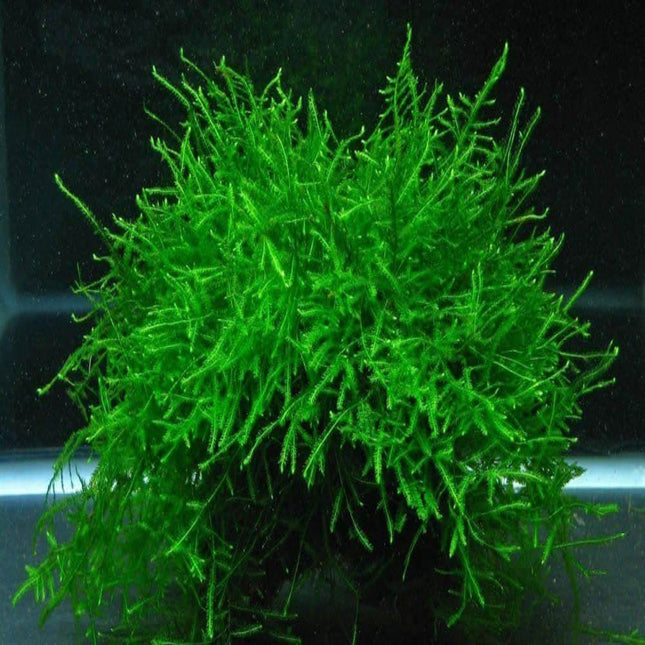
Java moss is one of the easiest to grow, and hardy, aquarium plants around. It belongs to the Hypnaceae family and is native to Southeast Asia. It is very common in moist tropical climates and grows on rocks, river banks and tree trunks. Due to its low requirements regarding water quality and lighting, it is perhaps the most common moss amongst freshwater aquarists and is widely available both in shops and online. It is commonly used for aquascaping and can produce beautiful results. It also has many other benefits such as providing protection for eggs and fry, improving tank health and providing food for breeding fish. Category Rating Care Level: Very easy Growth Rate: Low to Bright Temperature: 15 to 30C (59-86F) PH: 5.0 to 8.0 Reference: https://www.fishkeepingworld.com/java-moss/ Portion Size: 5x5cm when laid out flat which equates to 5 grams weight (without excess water) We send Java Moss orders via Unregistered post
$5.00
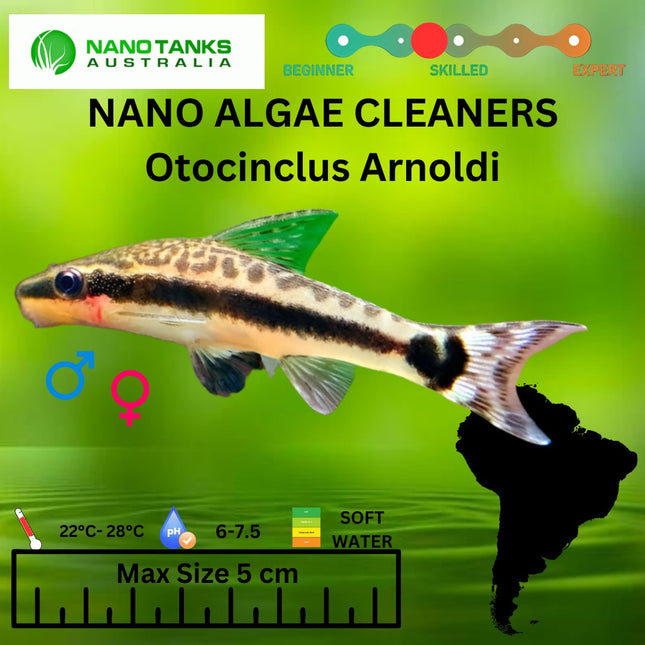
OVERVIEW Otocinclus Arnoldi, or as they are also called Otos, Otto Cats and Ottos. They may be the best scavengers for freshwater aquariums! These little guys eat algae but should not be confused with other similar looking fish that we sell such as Chinese Algae Eaters, Siamese Flying Foxes and Siamese Algae Eaters so make sure to check that before making a purchase. Otocinclus Arnoldi is the friendliest and most adorable little fish you could keep in your aquarium. They’re so easy to care for, provide hours of entertainment with their inquisitive nature, and they eat up all that pesky algae before it can grow out of control! HABITAT Otos are native to South America and can be found east of the Andes throughout the lowlands from northern Venezuela to northern Argentina. They spend most of their time in schools, swimming through moderate-to-slow rivers with well-oxygenated water. BUYING HEALTHY OTOS Otos are a great addition to any tank, but they’re very fragile. To make sure you don't lose them before the end of their first year, it's important that you pick out healthy Otos from your local fish store- if possible try and take some advice on what breeds will work best for your aquarium. BEHAVIOR If you keep your Otos properly, they'll show a ton of activity and personality during the day. They're industrious workers that will spend most of their time sucking on rocks, leaves with algae growing or anything else in sight! It doesn’t matter which species of Otocinclus you own, they all require the same water conditions – low stock density and pristine water – depending on your water source, you may want to use an RO system. AQUARIUM There are many reasons why you should consider getting an aquarium. For one, they can be a great avenue for relaxation and stress relief while making your home feel more inviting. Having fish also helps to improve the quality of air in our homes by producing negative ions that combat positive ones (i.e., it freshens up the room). To make sure your tank is healthy and happy, follow these guidelines: - You'll need an aquarium filter capable of cycling at least four times per hour (GPH) and with mature nitrate levels between 0-20ppm - No measurable ammonia or nitrite should be present either. - Otos prefer water with a stable pH that is slightly acidic (6-7.5). - The temperature inside their tanks should average about 72°F - 82°F degrees Fahrenheit (~22 °C ~ 28 °C) which allows them to thrive year-round without sustaining damage from changes in heat level outside. OTOCINCLUS Arnoldi SIZE The Otocinclus Arnoldi is a small fish that can grow to be about 1 ½ - 2 inches when fully mature. These quick and agile swimmers are able to dart from one end of the tank to another in an instant, making them ideal for smaller aquariums or tanks with slower-moving inhabitants. TANK MATES Otocinclus Arnoldi is known for being non-aggressive by nature. But because these tiny fish live in the wild, they have no means to protect themselves. If you choose tank mates wisely, then your Otos will be just fine! Otocinclus Arnoldi may not seem like much to look at with their small size and see-through skin but there is a reason why people keep them as pets; otos are peaceful little creatures that don't bother anybody or anything else in their home aquarium thanks to their lack of aggression which stems from living out on land without any natural predators where it has easy access food sources such as algae off rocks and plants around waterways. FEEDING Algae is the main food for Otos, but many aquariums can't produce enough to sustain them. If this happens in your tank, use algae wafers or Catfish pellets as a supplement. BREEDING Otos are hard to breed because you can't see a difference. But, female Otos tend to be larger and wider than males if you look closely enough for the little details. octocinclus
$24.00 $15.00
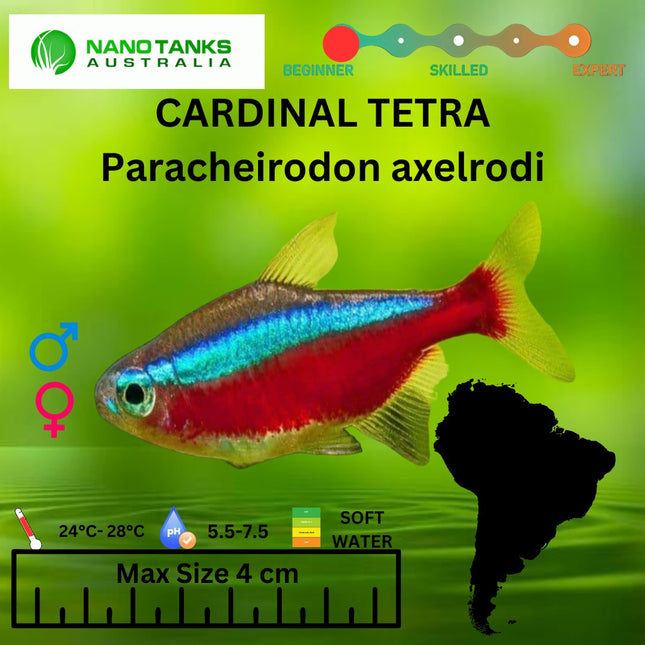
The Cardinal Tetra is a popular freshwater fish that many people enjoy keeping in their home aquariums. Cardinal tetras will quickly become one of the favourite fish in your aquarium. These tiny, schooling fish are hardy and playful—so much so that they can outsmart even seasoned aquarists! Cardinal tetra is a friendly fish that shares space generously with its tank mate. While they can be hard to breed in captivity, these brightly coloured fish stay active and are available in multiples colours of red, yellow, and orange. Habitat The cardinal tetra is most commonly seen in slow-moving, shallow water. They mainly eat small animals on plants roots and leaf litter but have been known to take live prey as well. The Cardinal Tetra (Paracheirodon axelrodi) is a fish that has been around for centuries. Originating from the rivers in South America, specifically the upper Orinoco and to the Rio Negro River. These little guys are fascinating because they usually only live about 2-3 years due to their small size but have still managed to thrive since then. Colour A Cardinal tetra is not only beautiful, but it's an excellent fish for almost any aquarium. Consider these benefits; they're small and sturdy enough that they can live in a 20-litre tank. They are tolerant of water quality fluctuations and the temperatures found in your home or office environment. Plus, they grow up to just 5cm long, so their accommodations will be easy as pie! And while we know you'll want to buy this beauty some friends once he gets settled in his new digs, don't worry about other types of fish bothering him—he'd rather eat plants than other aquatic life forms! Potential Tank mates for Cardinal Tetras Cardinal tetras are one of the most popular fish species. They should always be kept in large schools and prefer to swim around with others, even if they're not their kind! If you want your tank to have the perfect balance between lively company and a serene environment for some time alone, then these guys will become part of it. Potential tank mates that may be suitable other than tetras are Danios, Rasbora, and Dwarf Gouramis. If the companion fish has a big mouth enough to swallow the cardinal tetra, it is not a suitable tank mate. Cardinal Tetra Care There are a lot of reasons to purchase a larger aquarium. One of the most important is that Cardinal Tetras live better in bigger tanks! These fish can be seen living happily and healthily in tanks with 20 litres, but we always recommend going as big as you possibly can if you wish to enjoy the fish schooling to full effect. Cardinal Tetras are delicate and need mature tanks with soft acidic water to thrive. They can't survive in a tank that's only been set up for an hour, so use caution if you're new! Luckily they love having stable conditions because it lets them live longer lives without getting sick as often. The best pH is below 6, while the hardness should stay below 4 dGH (decigrams per litre) since high levels of minerals make their health deteriorate quickly. Finally, this species loves warmer temperatures but does well from 23°C to 27 °C. We recommend having Floating Plants on their tanks; not only do they moderate the light, but floating aquatic plants also help with CO2 and oxygen levels in the water. Diet and Feeding Cardinal Tetra will eat most foods, but be sure to feed them 75% of high-quality flake food, so they stay healthy! Make sure to provide live foods or frozen snacks for your little guys, including brine shrimp and bloodworms that are high in protein. If you're going to feed them all day, try offering three minutes' worth of food every feeding--their little mouths can't handle large pieces very well. Gender Identification Males and females show few apparent differences between the sexes, with female cardinal tetras having a deeper body than males with an almost round belly. The hook protruding from the male's anal fin tells other prospective mates they are mature enough to breed! Breeding Cardinal Tetras Breeding cardinal tetras is a difficult task. But if you are persistent, success will be within your grasp! The female cardinal tetra produces eggs when she feels the need to reproduce - typically during evenings and late nights from 130-500 eggs. A separate breeding tank with stable water conditions, a pH of 5.0 to 6.0, and very soft water 3-5 dGH or below is essential for success. FREQUENTLY ASKED QUESTIONS What is the Difference between Neon Tetra and Cardinal Tetra? The most obvious difference between the Cardinal and Neon Tetras is their coloration. While both are beautiful in their own right, it's hard to ignore that for Neons, only half of its body sports a vibrant red stripe while Cardinals have an equally colourful anal fin and gills as well as whole-body stripes. The main differences between these two fish types come down primarily to colouring: one has less than dazzling colours on about 50% of his body (Neon), where the other will stun you with brilliant blues, greens, yellows--even oranges! Of course, some structural distinctions like fins, but we are all more interested in how they look when swimming around our tanks anyway. Can a tetra live without a filter and heater? A tetra can live without a filter yes, a heater not so much. Below 24 degree's C your tetra will not be happy campers, however a regular water change can suffice in lieu of a filter.
$6.00
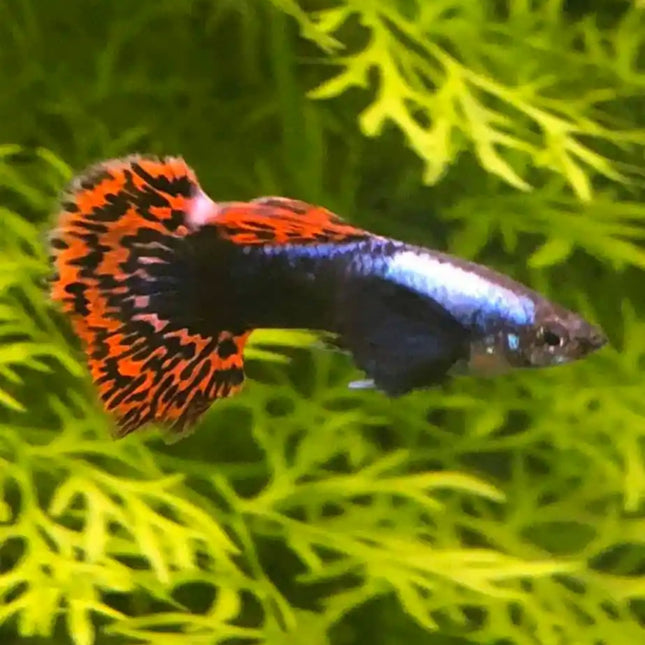
Elegance in Motion. The Crown Jewel of the Guppy World. Introducing the breathtaking Dumbo Mosaic Guppy, a strain that combines two of the most sought-after traits in fancy guppies. Marvel at the enormous, ornate tail adorned with a intricate, mosaic-like pattern of deep blacks, vibrant blues, and fiery reds. Then, be captivated by their namesake "Dumbo" ears—massive, elegantly flapping pectoral fins that make them appear to float like butterflies through your aquarium. This is living art, perfected through selective breeding. Key Features & Benefits: Double Feature Beauty: Experience the stunning Mosaic tail pattern combined with the unique Dumbo (Elephant Ear) pectoral fins for a guppy unlike any other. Captive Bred for Excellence: Our line is selectively bred for vibrant color, robust health, and those signature magnificent fins. They are adaptable and hardy. Constant Activity: Their graceful, flapping swimming motion is a mesmerizing display that brings life and movement to the top levels of your aquarium. Livebearer Ease: Perfect for hobbyists of all experience levels, from beginners to advanced breeders looking to work with a premium strain. Proven Breeders: A fertile pair will provide you with a steady supply of beautiful fry, allowing you to grow your collection or share with other enthusiasts. Product Details: Scientific Name: Poecilia reticulata Common Name: Dumbo Mosaic Guppy, Elephant Ear Mosaic Guppy Origin: Captive Bred Temperament: Peaceful, lively, and social. Size: Males: 3-4cm, Females: 4-5cm What to Get: We recommend starting with a 1 Male & 2 Female trio to ensure a harmonious group and successful breeding. You will receive young, healthy, and sexually mature fish. Care Guide: Recommended Tank Size: 40 litres / 10 US gallons minimum for a trio. Larger tanks are better for maintaining a colony. Water Parameters: Temperature: 22°C - 28°C (72°F - 82°F) pH: 7.0 - 8.0 (They appreciate harder, alkaline water) GH: Prefer moderate to hard water. Diet: Omnivore. Thrives on a varied diet of high-quality guppy flakes or micro-pellets, and frozen or live foods like brine shrimp or bloodworms for optimal color and health. Habitat Setup: A filtered, planted aquarium is ideal. Provide some floating plants to give fry a place to hide. Their long fins can be tempting to nippy tankmates, so choose companions carefully. Who is this guppy for? The Dumbo Mosaic Guppy is the ideal choice for: The aquarist who appreciates the pinnacle of fancy guppy breeding. Beginners looking for a beautiful, hardy, and rewarding fish. Breeders and hobbyists seeking a high-quality strain to work with. Anyone wanting to add a splash of color and elegant movement to a community tank. Order with Confidence: Your live fish order is handled with utmost care. We package all livestock with professional breather bags and insulated boxes, complete with heat or cold packs as needed to ensure a safe journey to your door. ⚠️ Please Note: The size, color, and pattern of livebearers can vary slightly from the parent stock. We strive to provide the highest quality specimens. Long-finned fish should only be kept with peaceful community fish to prevent fin nipping. FAQ Section (Suggested for the product page): Q: What is the best tank setup for these guppies?A: A spacious, well-filtered planted tank is ideal. They appreciate gentle water flow due to their large fins. Include hiding spots for fry if you wish to breed them. Q: What are good tank mates for fancy guppies?A: Excellent peaceful companions include Corydoras catfish, Small Tetras (Neons, Embers), Endler's Livebearers, and peaceful shrimp. Avoid fin-nippers like Tiger Barbs or larger aggressive fish. Q: How can I tell males from females?A: Males are far more colorful with large dorsal and caudal (tail) fins, a slender body, and a gonopodium (modified anal fin). Females are larger with a rounded abdomen, are less colorful, and have a traditional fan-shaped anal fin. Q: Will they breed in my tank?A: Yes, very readily! They are livebearers, meaning the female gives birth to free-swimming fry. To increase fry survival, provide plenty of plants like Java Moss for them to hide in.
$8.00
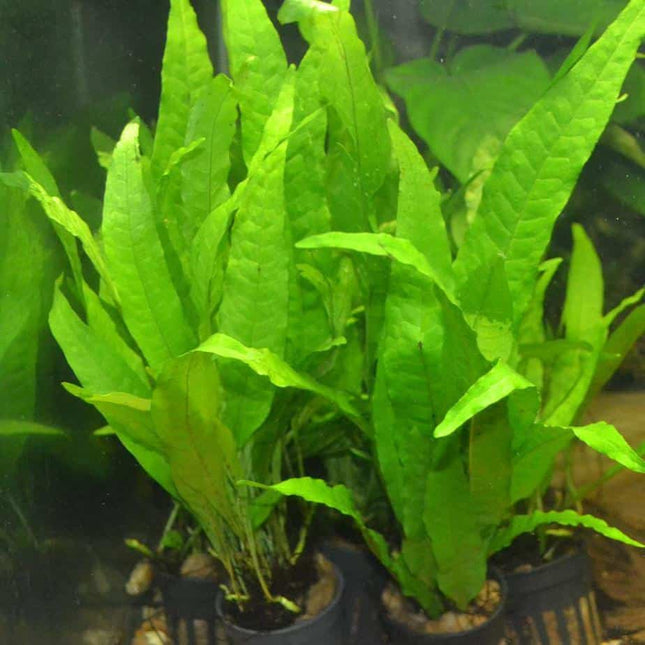
JAVA FERN: THE BEST PLANT FOR YOUR PLANTED AQUARIUM Java ferns (microsorum pteropus) are perfect for aquariums. They're small, easy to grow, and don't need a lot of light to survive. Ask us for varieties we have available. For example, there are needle leaf varieties that require bright lights, as well as more traditional 'jungle' leaves such as the Narrow Leaf, Lance Leaf, and Windelov – their many varieties to suit your needs inside your aquarium. Your fish will appreciate the natural hiding spots provided by Java Fern so they can get away from time to time and feel safe and secure when they want it. Identification If you want a true aquatic plant that can grow when submerged in water or even partially out, then the Java fern is perfect for your tank. Our diverse line of beautiful and delicate-looking Java plants are perfect for people who prefer an aesthetic look inside their home aqua garden without crazy maintenance requirements. When you require a go-to plant that looks great in almost any aquascapes, go with Java Ferns (from Nano Tanks Australia with our aquascaping expertise, of course!). The narrow-leaf Java fern generally boasts long, skinny leaves, with the plant growing to a height of 10-12 inches (25-30 cm). Java Fern is perfect for those who have limited space or are trying to create an artificial jungle feel in their aquarium. The plants need bright light, but indirect (not right under the light), so they can grow properly. Keep in mind the sun has a much more potent energy than your tiny aquarium lights, so aquarium keepers can tend to underestimate the wattage and spectrum required. Saying that, in nature Aquatic Java Fern tends to never receive direct light in the jungle river. So although the Java Fern will be fine with low light in the tank, its growth rate will not impress you. What You Should Know about Java Fern It's probably better than any other plant that would grow inside an aquatic environment for this reason - its fronds are big enough for fish to swim through them without getting stuck between leaves. A striking addition to any freshwater planted aquarium, perfect if you have cichlids or South American fish. Fortunately, it's also relatively easy for plant-eating goldfish and other tank mates to leave it alone because of its tough rhizomes! Java Fern does well in water with pH levels between 6-7.5, as long as the alkalinity stays below eight dKH (aka carbonate hardness). If you see black spots (or brown spots) in your plant's leaves, don't worry - they do that. Java ferns have veins running through them, and sometimes new bumps will pop up on the leaf from which a new shoot emerges. Planting and Replanting Java Fern in the Aquarium Java ferns grow beautifully with other live plants since they are so robust, but they also make a great centrepiece for the aquarium when planted alone. Alternatively, you can attach java fern to aquarium decorations (like rock or driftwood) to create an elegant look that will not overwhelm your fish tank with too much greenery! Java Fern is a hardy plant that can live in any tank size, making it perfect for apartment dwellers who don't have room for large aquariums! If the water stays clean (and you're not adding liquid fertiliser), this resilient Fern's growth will remain consistent without any problems. The Fern prefers water with soft-to-moderate temperatures of 22 degrees Celsius. Data at a glance for Java Fern Family: Polypodiaceae Care Level: Easy Growth Rate: Low to Moderate Maximum Size: 30cm Minimum Tank Size: 20 Litres (tall tank) Water Conditions: 20-28°C pH 6.0-7.5 KH 3-8 Lighting: Low to Moderate (Depending on the desired rate of growth) Propagation: Adventitious Plantlet/Rhizome Division Placement: Mid to Background
$15.00

The following are on offer in an assorted basis:Mi OyaLuteaHybridPetchiiWalkeriFamily: AraceaeOrigin: Sri LankapH: 5.5 – 8Temperature: 20 – 30° CHeight: 5 cm – 40 cmLighting: Low
$10.00
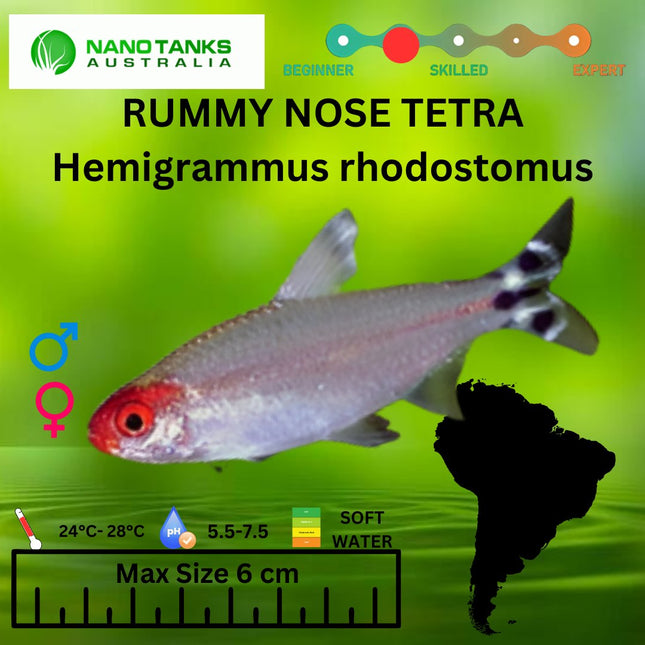
Category Rating Care Level: Moderate Temperament: Peaceful Color Form: Silver body, red nose, black/white striped caudal fin Lifespan: 6-8 years Size: 2-2.5 inches Diet: Omnivore Family: Characidae Minimum Tank Size: 20 gallons Tank Set-Up: Planted freshwater tank with open swimming space Compatibility: Peaceful community aquariums
$6.00
![Carbon Cherry Shrimp 1 - 3cm [NO SHIPPING TO WA OR TAS] - Nano Tanks Australia Aquarium Shop](http://nanotanksaustralia.com.au/cdn/shop/files/carbon-cherry-shrimp-1-3cm-no-shipping-to-wa-or-tas-701541.jpg?v=1741081843&width=645)
Carbon Cherries comes from blue dream cherry shrimps. These shrimps are more grey in appearance and undesirable when it comes to selective breeding Blue Dream Cherry Shrimps. However they are a strong line and they can give birth to very nice carbon colours with the odd blue cherry shrimps as well. Cherry Shrimps RCS Neocaridina davidi is one of the most beautiful and sought after shrimp in the hobby today. They are easy to care for and easy to breed in a freshwater aquarium. These freshwater shrimps also are priced for the beginners market. Red Cherry Shrimp When you get our shrimps they are mostly a B or C class shrimp. This means that they will appear red, however their quality is not as consistent as the highest grade. We do have Bloody Mary and Fire Red Shrimps that come from time to time however these strains are hard to get and there are cost implication that come with them. If you are interested in these premium kinds of shrimps please message us. Blue Cherry Shrimp & Yellow Cherry Shrimp These colour variations are not as popular as red cherry's however they look amazing in their own way. Our particular variant of Blue Cherry Shrimp is called Blue Dreams. Our Yellow Cherry Shrimps can look quite stunning against particular backgrounds. Living Conditions Dwarf Shrimps are adaptable to a wide variety of tank conditions and water parameters. They can withstand temperatures to around 15°C through to 30°C. However they do prefer to be around 22°C to 26°C. The shrimps are also tolerable in a wide array of pH. However they do better when the pH is around 6.5. RCS (Red Cherry Shrimp) is very tolerable to TDS levels however, we recommend you keep your TDS (Total Dissolved Solids) to around 200ppm max. The History of Shrimp in Australia Red Cherry's appeared in Australia in the early 2000s. The price at this time was quite high and the shrimps unfortunately were not very nicely coloured. The price of the shrimps, fortunately, tumbled quickly as people discovered that they were very easy to care for and breed readily. In 2014 they reached around 50 cents (!!) AUD and people started giving up on these shrimps just because they were easy to breed. When we opened in early 2014 we were fortunate to be the first shop to sell these shrimps in bulk and we were proud to be selling them as low as $1 per shrimp (at that time). However, as we fast forward to the present and beyond, the price of these shrimps has increased steadily due to the necessary upkeep requirements for ensuring healthy shrimps for sale. Now, these shrimps are more than a staple in the Aquarium hobby and a great addition to add for those starting out in shrimp keeping and Aquascaping in general. What fish live with red cherry shrimp? There are a lot of fish that live with red cherry shrimp. You should consider keeping it with anything that won’t target the shrimp. The Red Cherry Shrimps make an irresistible target to predation. To keep it safe and as a rule of thumb, don’t keep shrimps with Barbs, Bettas or anything that can predate it. Even if the fish do not eat the shrimp, having planted aquariums allow for a safe place so your cherries are happy. How long do red cherry shrimp live for? Cherry Shrimps live for around 1-2 years. However, remember that when they are born they are born live and you can observe little shrimps in the tank. Most stores will sell shrimps at around 3-6 months. At this stage it is the best and ideal time for them to go to their new homes. Do Cherry shrimps breed easily? Cherry Shrimps breed very easily and to make sure they do breed, I recommend that you put them in with Bristlenose algae eater. The combination of having a Bristlenose and Cherry Shrimps means that they will consistently breed. Only use a sponge filter and do not keep with other fish if you wish for success. If the tank is new and does not contain sufficient algae, algae wafers are fine to use as this is what baby shrimps eat. Females who are carrying the eggs will have a cluster of between 30 and 50 eggs at a time beneath their tails. Properly bred, 10 shrimps can turn into 1000 in 6 months! Do cherry shrimp need a filter? Cherry shrimps do need a filter to live. However, don’t go overboard on the filtration. A simple sponge filter or internal filter will be more than sufficient for it. Do cherry shrimp eat fish poop? Cherry Shrimps don’t generally eat fish poop, however they will eat Bristlenose poo readily. I believe it is due to the wood that Bristlenose Eat that the Red Cherry Shrimps like as well. I do recommend that you also do feed your Cherry Shrimps to make sure that they are always in great form. Do cherry shrimp jump out of tank? Cherry Shrimps do not necessarily jump out of a tank. However if you give them a way.. like a filter wool climbing area or anything rough they will wonder around. When this happens please make sure that you keep your lids secure. How do you know if cherry shrimp are happy? You know that your cherry shrimps are happy because they will swim around readily and scavenge food in your tank. However, once they become still or unresponsive you will have problems. One of the worst you can ever do with shrimps is when you spray an aerosol in the house. Such as a fly spray or anything that will kill bugs. If and when you do this death will be swift! Why do shrimp drop eggs? Sometimes when RCS molt they might drop their eggs. This means that the eggs were not viable or there is a problem with the water conditions. When this happen we recommend you ignore it at first. However, if this occurs frequently we recommend that you get your water tested to make sure that everything is ok. Are red cherry shrimp Hardy? Red Cherry Shrimps are hardy. They can be totally ignored and you don’t need to really worry about them. The old adage with shrimps is that the more you care for them the worst they can get. What plants do cherry shrimp like? Shrimps loves mosses or anything that they can hide and cover themselves in. If you are looking for things like Susswassertang or Java Moss these are the simplest and the best options. Can cherry shrimp live with bettas? Before we answer the question can Cherry Shrimps live with Bettas, we need to clarify the question further and make it more specific. One betta cannot live with one Cherry Shrimp. One will be food and one will be full. However, if you have 1 betta with say 12 shrimps and heaps of cover in the tank they they can live together with no issues. The reason for this is because it is hard for the betta to focus on the one shrimp. Can you eat red cherry shrimp? You can but why would you? A cherry shrimp is such a small size and you will need a lot of it to really make a meal out of them. If you intend to breed for your human consumption, I would strongly advise against it. We do not send shrimps to WA, TAS or NT
$6.00